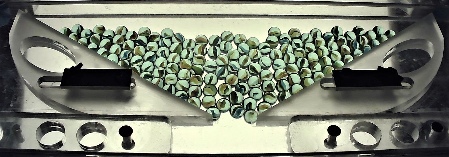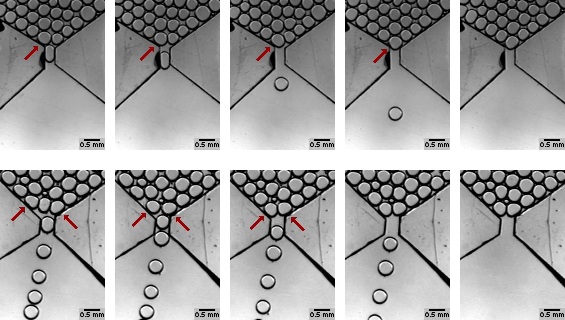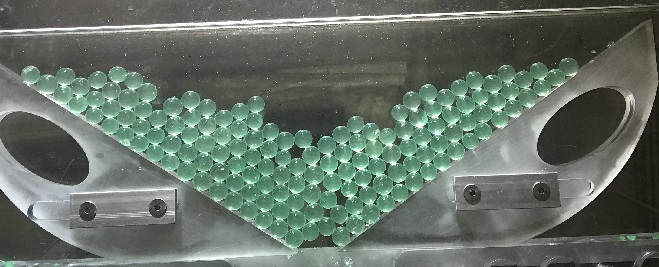
(photo from Ran Tao.)
Clogging has been studied for decades, mostly by engineers who need to understand solid particles flowing out of containers -- think corn, coal, gravel, etc. Our work has focused on soft particles such as oil droplets and hydrogel particles, as shown in the next two pictures:
| Picture at right: Oil droplets forming clogs as they exit a funnel. The droplets are between two parallel glass plates, so they are deformed into pancakes. Click here to see a movie of the clogging event shown in the bottom row of images. (Photos and video from Xia Hong.) | 
|
| Picture at right: Hydrogel particles forming a clog. The particles are about 1.5 cm in diameter, and the exit opening width is 2.88 cm. The apparatus is tilted so that it is nearly horizontal to reduce the driving force of gravity (10 degrees inclined from horizontal). (Photo from Mia Morrell.) | 
|
The bottom graph shows our simulation data. We use the Durian bubble model to simulate the flow of soft particles; you can click here to download our IDL code for these simulations. Click here to see an animated GIF movie of one of our simulations. And this is a close-up movie of the same data, with inter-droplet forces highlighted. For these movies, w/d=2.2 and the data correspond to the blue circles of the bottom clogging graph.
The simulation lets us vary gravity by three orders of magnitude. As with the hydrogel particles, the lower the gravity, the easier it is to clog -- we can get clogging even with large values of w/d, more than three diameters wide.
The main idea here is that when gravity is big (or the particles are very soft), the weight of the particles on top will make the particles underneath deform. The soft particles can't form an arch, or at least, if they try to form an arch, the weight causes that arch to break. But when gravity is small (or the particles are harder), it is easier to form a permanent arch that can support the weight of the particles above it.
What's fun about our results is that they are the exact opposite of what people have seen for years with hard particles! With hard particles, there's a phenomenon called "faster is slower." This is easiest to understand with people trying to leave a crowded room through a narrow doorway. If nobody is in a hurry, then people can exit fairly efficiently. If people are rushing, then you can form an arch of people at the doorway, and the crush of people from behind can prevent the people in the arch from being able to move and disrupt their arch. Thus, the flow of people out of the room is actually slower than when people aren't in a hurry.
The key difference is that with people exiting a room, they are moving somewhat randomly. If they form an arch, they're going to continue to jostle each other to break free. And if coal flows out of a container and gets stuck, you'll bang on the container to break the clog. In this case, the pressure of coal above will stabilize the arch against being jostled by your banging on the container. In contrast, with soft particles, we don't have random jostling or banging. If a clog forms, it is stable. And instead, if we have a larger driving force (larger gravity), this causes the arch particles to deform and rearrange enough to break the arch and flow will resume.
This does raise the question of whether adding vibrations to our system will cause it to unclog. Mia Morrell did some experiments showing that indeed this is the case, although we did not ever see the "faster is slower" effect.
We did some additional experiments and simulations related to flowing oil droplets. Briefly, in these cases we allowed the pressure to build up if the system clogged, until the pressure causes the arch to break, at which point the pressure drops. Thus, we never had permanent clogs. Instead, we found that the flow rate was intermittent, especially when we tried to pump the droplets at low flow rates. In these cases we'd get a clog followed by a big avalanche where many droplets flowed out. When we tried to pump faster, the flow was steadier. We were able to explain these results in terms of the system compliance; see the 2022 paper by Xia Hong for details (link at the top of this page).